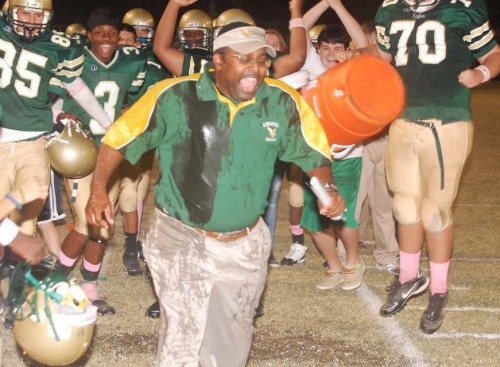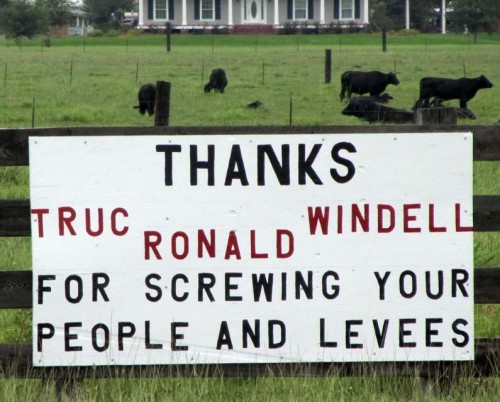Monday, Oct. 25
October 25, 2010
Parish Champs! Evergreen stumps rival, completes perfect season
October 27, 2010The South Lafourche Levee District failed a maintenance inspection conducted by the U.S. Army Corps of Engineers two weeks ago and is now working toward meeting established guidelines by August 2011, according to the district’s General Manager Windell Curole.
The corps was not satisfied with an excess amount of sand and moisture in the levee’s mixture, but Curole remains confident that the SLLD will pass inspection in time for the 2011 hurricane season.
“They had been warning us of some of the problems,” he said. “We continued improving the levees and doing what is best for flood protection, and we’re going to work toward solving those problems. We think we can get there for next hurricane season.”
The inspection guidelines are not to be confused with stricter standards imposed in 2006, when the corps implemented standards too expensive for the SLLD to attain. This resulted in South Lafourche levees being decertified.
The new standards encompass many different aspects of the levee construction process, including enhanced geotechnical analysis and safety measures. But the one measure that gives the SLLD the most issues is a demand for instant strength through a purer, drier mixture.
“We’ve been constructing the levees the old way of building, when you put wet material in a levee section,” Curole said. “We just can’t afford to dry it before you put it in. That costs too much money.”
According to the levee director, it’s difficult to locate the field material necessary for the corps’ desired mixture in the surrounding area. Instead, they would have to pay for it to be brought on a truck, which would in turn cause a drastic rise in cost.
“They’ve gone to that higher standard, and it’s forced us to have almost pure clay. It’s much more expensive to find and to bring it on-site. Of course, if you’re lucky enough to have the clay right next door, well then it’s no big deal, but that’s not the case,” he explained.
With time, the South Lafourche levees constructed under the old standards will meet the corps’ strength demands, Curole predicted. It’s not immediate, but it is cost-effective and is the same method that protected the area during hurricanes Katrina, Rita, Gustav and Ike.
Curole said he spoke with a contractor who is currently working on a 4-mile South Lafourche levee and has complied with stricter standards in New Orleans. He said the contractor told him the same project, which takes 18 months and costs $6 million, would last three years and cost $20 million under the new standards.
Murphy Broussard, a Galliano resident who said he has been to the SLLD offices multiple times to read their correspondence with the corps, is concerned the SLLD has not exhausted all of its means to raise money and adhere to the corps’ stricter standards.
“The old cliché holds true: pay me now or pay me later,” Broussard said. “Either we do it correct the first time or we have problems with it later. They’ve never given that option to the public.”
He suggested that parish residents would possibly agree to an increase in sales tax or a millage if the levee district would propose it because they are already paying extra money on their flood insurance premiums, which increased when the South Lafourche levees were decertified.
“I think they would be concerned about the outcome, all the consequences of not building this levee by corps’ standards,” Broussard said. “I think they would approve it. I think be it a millage raise, a one-cent sales tax or bonding out some of the monies. I’m not quite sure of some of the avenues they would take, but as a Lafourche Parish resident, I haven’t seen them do any of that.
“I just think they have to become a little more creative as far as raising money for this. I don’t know what the answer is, but I know there is an answer. They’re just not searching hard enough for it.”
Broussard drew an analogy to another recent disaster that was caused by a lack of preparation.
“What BP did was cut corners,” said Broussard, who works for Exxon-Mobile. “They should have spent more money to get this [blow-out preventer] correct. The levee district is doing the same thing. Nobody thought this would happen to BP or any oil company.
“The same analogy applies to the South Lafourche levees,” he continued. “We don’t’ expect another hurricane, but if you’re not building to the corps standards, it very well could happen, and it’s all going to fall back to not wanting to spend the right kind of money to get it done.”
The circumstances that led to the Deepwater Horizon explosion in the Gulf of Mexico might compare with the issues facing the SLLD as far as precaution, but the SLLD will never have an amount of money comparable with the oil company.
As of now, the issues the SLLD face center on not being able to meet the corps’ standards, which may have resulted from an overreaction and public backlash toward the government agency.
After a multitude of strong storms during the 2005 hurricane season, the strength of the computer-generated 100-year storm increased to projecting a 26-foot storm surge. A storm of this magnitude would overtop the parish’s levees whether they meet the new standards or not.
The levees in New Orleans didn’t fail during Hurricane Katrina because they held up until the water level reached the height of the barriers, and the public’s overreaction and confusion of the situation led to the stricter standards, Curole said. He wrote an article on the subject, which can be found at slld.net.
Although the levees met their expectations, some of the hard-structure protection failed, which caused the flooding. The corps bore the brunt of the blame, and they responded with regulations that are impossible for a small parish to financially adhere to.
The New Orleans levee system will be able to meet the new guidelines thanks to federal appropriation, but the SLLD has not been afforded that luxury.
“We are the only authorized system outside of the New Orleans area that did not get any substantial money and help,” Curole said. “So, it’s really kind of ironic that they say, ‘We’re not going to give you any more money.’ And we’re in the position we are because they didn’t give us any money.”
The SLLD receives all of its revenue from a one-cent sales tax, which totals about $7 million annually. They spend $1.5 million on maintaining the current levees and the remainder goes toward construction.
They also received $20 million from the state surplus a year ago and $29 million in federal funds that is dedicated to hard structures like floodwalls New Orleans received 100 percent of the funds – doled out in billions – necessary to bolster the levee system in 2006.
“We kind of got the crumbs from New Orleans, basically,” Curole said.
Galliano resident Murphy Broussard’s sign portrays his dissatisfaction with the South Lafourche Levee District. Broussard is upset the SLLD isn’t thinking of creative measures to raise the money necessary to meet enhanced U.S. Army Corps of Engineers levee standards. COURTESY PHOTO










